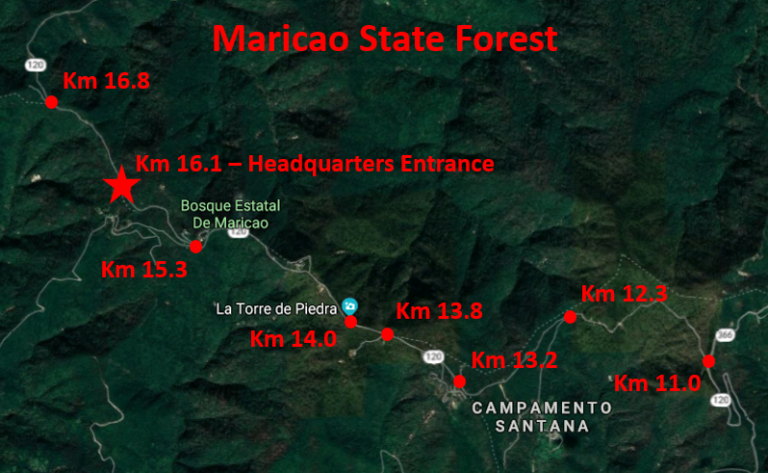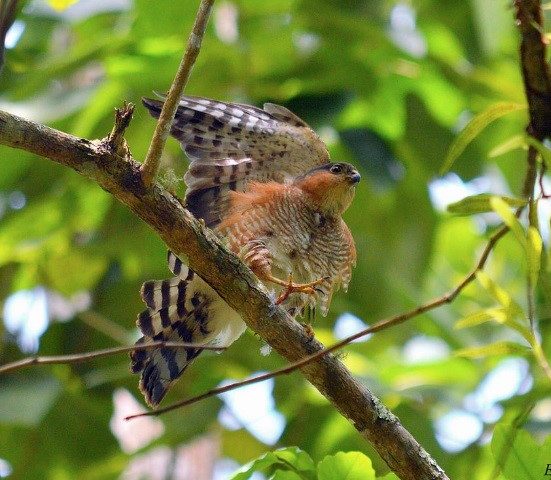Maricao State Forest, Puerto Rico

Maricao State Forest is the best place to find the rare Elfin Woods Warbler, among other montane species such as Puerto Rican Tanager. The main road through Maricao runs along the spine of the island’s tallest mountain range, the Cordillera Central, with several short trails that provide access to the cloud forest. It is also the last stronghold of the “Puerto Rican Sharp-shinned Hawk”, which may qualify as a separate species but in is imminent danger of going extinct before gaining that recognition.
Orientation
Directions
A little over two hours’ drive (170 km) southwest of San Juan, 50 minutes (50 km) west of Ponce, and 45 minutes (25 km) east of Mayagüez.
Several routes lead to Maricao State Forest, all on narrow, twisty mountain roads. The most efficient access is from the southeast, via Sabana Grande. Travelers on a circuit may prefer to arrive from the west through Mayagüez or the interior through Lares. These roads are scenic, but slow.
From downtown Sabana Grande, take Calle 65 de Infantería (which becomes PR-120) north—follow the signs to “Monte de Estado.” This road winds up steeply into the hills and after 11 km (at the junction with PR-366) becomes the Ruta Panorámica through Maricao State Forest. The drive from Sabana Grande takes about 20 minutes.
Birdfinding
Maricao Birds. Maricao State Forest supports most of Puerto Rico’s endemics and other species of interest, including: Scaly-naped Pigeon, Ruddy Quail-Dove, Puerto Rican Lizard-Cuckoo, Green Mango, Puerto Rican Emerald, Puerto Rican Tody, Puerto Rican Woodpecker, Puerto Rican Pewee, Puerto Rican Flycatcher, Puerto Rican Kingbird, Puerto Rican Vireo, Black-whiskered Vireo, Eastern Red-legged Thrush, Pearly-eyed Thrasher, Puerto Rican Euphonia, Puerto Rican Oriole, Adelaide’s Warbler, Puerto Rican Spindalis, and Puerto Rican Bullfinch.
The main access to Maricao is via the 9 km segment of PR-120 between its junctions with PR-366 (at Km 11 on PR-120) and PR-105 (around Km 20, just uphill from the town of Maricao). There are several side-roads and trails that can be explored. The ones that were accessible ten months after Hurricane María are listed below—the kilometer posts correspond to roadside markers that measure the distance from Sabana Grande. If you are in a hurry, go straight to the headquarters area at Km 16.1.

Km 12.3, Campamento Santana. A paved side-road leads downhill to a large but mostly disused Forest Service compound. Just above the gated compound, an old, unmaintained gravel road heads off to the right. This old roadbed is walkable for some distance through semi-open forest, eventually becoming overgrown and blocked by many fallen trees.
Km 13.2, Centro Vocacional Monte del Estado Maricao. Across from the vocational center is a short road that dead-ends at a clearing, mainly a trash depositary, where Elfin Woods Warbler is sometimes found.
Km 13.8, Parque Ecológico Monte del Estado. A gated camping area that has been recommended by some visitors, but is not always open.

Male Elfin Woods Warbler at Maricao. © Michael J. Morel
Km 14.0, La Torre de Piedra. A stone tower that is open to the public but little-visited. Inside the tower, a short staircase goes to the top for a panoramic view. “Caribbean Black Swift” can sometimes be seen from this vantage point, but Cave Swallow is the predominant aerial insectivore.
Km 15.2, Radio Towers. There are two pull-offs on the north side of PR-120 that give access to a small amount of habitat.
Km 15.3, Camino Casa de Piedra. This path on the south side of PR-120 follows a powerline cut down to the Forest Service Headquarters, arriving at the old stone house. About halfway down, a branch trail on the left connects to the old jeep trail.

“Puerto Rican Sharp-shinned Hawk” at Maricao. © Ernesto Burgos
Km 16.1, Forest Service Headquarters. The headquarters area is probably the best spot in Maricao to look for the local specialties. It is reliable for Elfin Woods Warbler and the only accessible location where visitors have regularly seen “Puerto Rican Sharp-shinned Hawk” in recent years.
The entrance road dips down from PR-120, runs roughly parallel to it for about 300 m, then turns uphill at a scenic overlook and promptly ends at a gate beside an electrical substation. You can park either beside the picnic shelter (with bathrooms) or at the overlook, and explore the following areas:
Entrance Road. A pair of “Puerto Rican Sharp-shinned Hawks” has nested just downhill and can sometimes be heard or seen around the midsection of the road. Feeding flocks that include Elfin Woods Warbler are often found along the last section on the uphill side of the road.
Scenic Overlook. There are two benches with a big view toward San Germán and Cabo Rojo. On the opposite side of the road is a short trail into the forest where Elfin Woods Warbler is often seen.
Stone House and Camino Casa de Piedra. Walking uphill from the overlook, around the gate, brings you to a large clearing occupied by an old stone house (Casa de Piedra). Continuing past the house is a wide path along a powerline cut that leads uphill and rejoins the main road at Km 15.3. About halfway up, a branch trail on the right connects to the old jeep trail.
Old Jeep Trail. Just below the overlook, on the right side of the road, is a yellow gate that blocks a disused road, now a trail. Just past this gate, the trail immediately forks. The right fork goes steeply downhill and becomes impassable after a few hundred meters. The left fork is the old jeep trail, which is easily walkable for a two or three kilometers, then becomes increasingly overgrown.
Km 16.8, Camino Descanso. This trail follows a ridge for a little over a kilometer through generally productive habitat, then eventually becomes overgrown. The first section is particularly good for Elfin Woods Warbler and Green Mango.
Services
Accommodations
For many years, the traditional lodging for birdwatchers visiting Maricao was Hacienda Juanita, but it has closed. In its absence, there are many less convenient, but still serviceable hotels in Mayagüez, San Germán, and the beach towns of the southwest: e.g., Cabo Rojo, Boquerón, La Parguera, and Guánica.
Because southwestern Puerto Rico has several sites of ornithological interest in fairly compact area, many visitors will want to establish a base in one of these towns and stay two or three nights, allowing for unscheduled exploration. The paradors in Guánica and La Parguera are good options for this approach.
Food
There are restaurants and grocery stores in Sabana Grande, 20 minutes’ drive southeast of the state forest. Even closer in the opposite direction is the small mountain town of Maricao.
Notes
When to Visit
As with other forested sites in Puerto Rico, the best time to visit is approximately February through May, when the endemics are most vocal and conspicuous.
Hazards & Hassles
There are two main problems with visiting Maricao State Forest: the roads and the weather. Like most of Puerto Rico’s mountainous interior, the roads are twisty and narrow, so driving requires extreme caution to avoid collisions with oncoming vehicles. The weather is often wet: this is a cloud forest site, so fog, mist, and rain are common.